HYUNDAI IONIQ ELECTRIC 2021 Owner's Manual
Manufacturer: HYUNDAI, Model Year: 2021, Model line: IONIQ ELECTRIC, Model: HYUNDAI IONIQ ELECTRIC 2021Pages: 546, PDF Size: 34.82 MB
Page 21 of 546
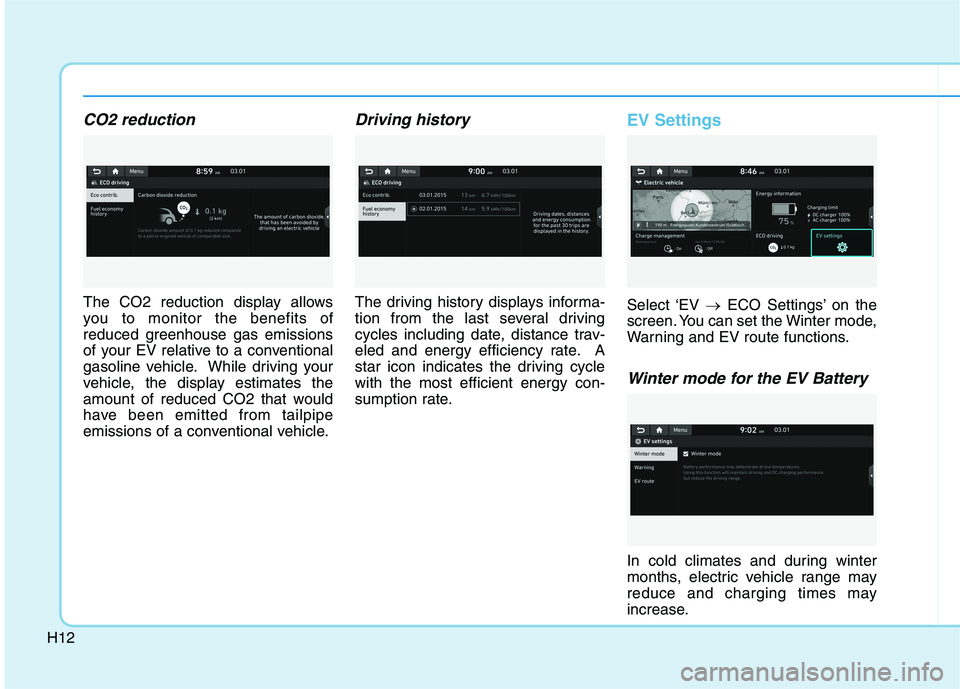
H12
CO2 reduction
The CO2 reduction display allows
you to monitor the benefits of
reduced greenhouse gas emissions
of your EV relative to a conventional
gasoline vehicle. While driving your
vehicle, the display estimates the
amount of reduced CO2 that would
have been emitted from tailpipe
emissions of a conventional vehicle.
Driving history
The driving history displays informa-
tion from the last several driving
cycles including date, distance trav-
eled and energy efficiency rate. A
star icon indicates the driving cyclewith the most efficient energy con-
sumption rate.
EV Settings
Select ‘EV �ECO Settings’ on the
screen. You can set the Winter mode,
Warning and EV route functions.
Winter mode for the EV Battery
In cold climates and during winter
months, electric vehicle range may
reduce and charging times may
increase.
Page 22 of 546
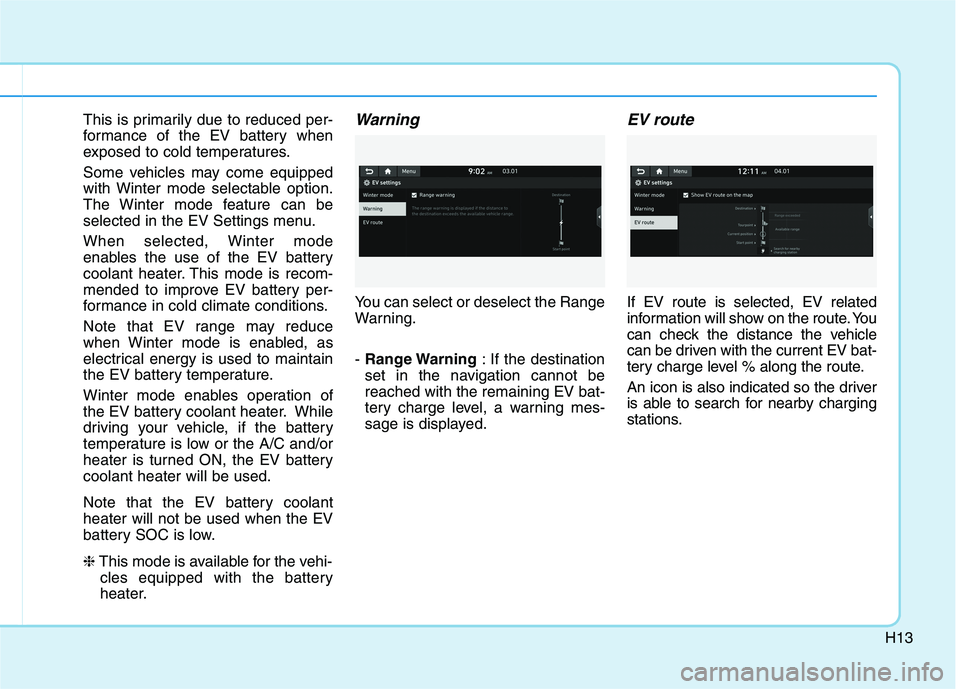
H13
This is primarily due to reduced per-
formance of the EV battery when
exposed to cold temperatures.
Some vehicles may come equipped
with Winter mode selectable option.
The Winter mode feature can be
selected in the EV Settings menu.
When selected, Winter mode
enables the use of the EV battery
coolant heater. This mode is recom-
mended to improve EV battery per-
formance in cold climate conditions.
Note that EV range may reduce
when Winter mode is enabled, as
electrical energy is used to maintain
the EV battery temperature.
Winter mode enables operation of
the EV battery coolant heater. While
driving your vehicle, if the battery
temperature is low or the A/C and/or
heater is turned ON, the EV batterycoolant heater will be used.
Note that the EV battery coolant heater will not be used when the EV
battery SOC is low. ❈This mode is available for the vehi-
cles equipped with the battery
heater.Warning
You can select or deselect the Range
Warning. - Range Warning : If the destination
set in the navigation cannot be reached with the remaining EV bat-
tery charge level, a warning mes-
sage is displayed.
EV route
If EV route is selected, EV related
information will show on the route. You
can check the distance the vehicle
can be driven with the current EV bat-
tery charge level % along the route.
An icon is also indicated so the driver
is able to search for nearby charging
stations.
Page 23 of 546
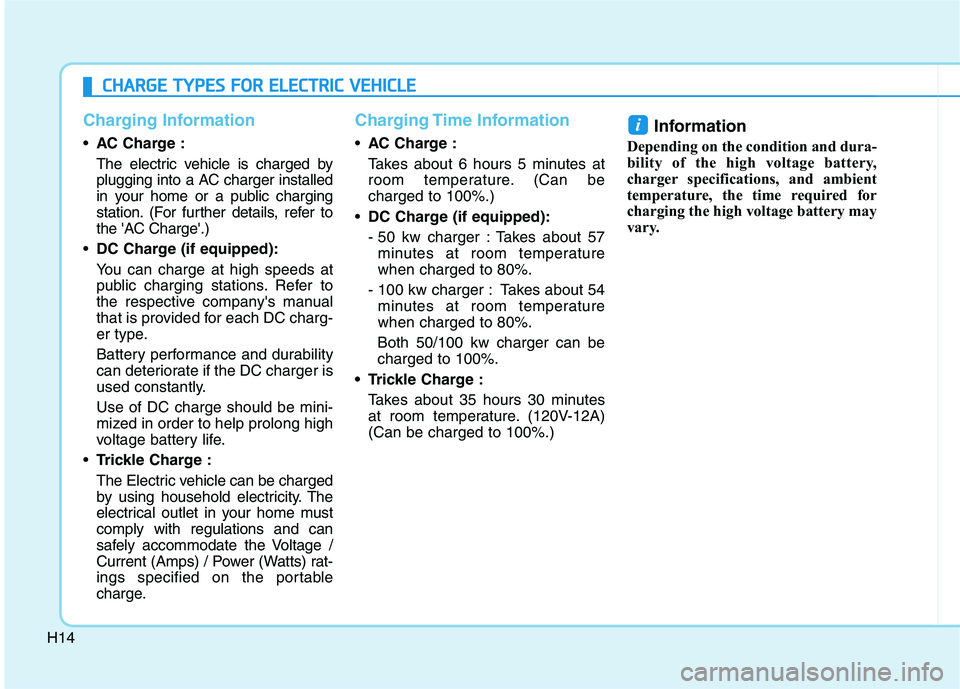
H14
Charging Information
AC Charge :
The electric vehicle is charged by
plugging into a AC charger installed
in your home or a public charging
station. (For further details, refer to
the 'AC Charge'.)
DC Charge (if equipped):
You can charge at high speeds at
public charging stations. Refer to
the respective company's manual
that is provided for each DC charg-
er type.
Battery performance and durability
can deteriorate if the DC charger is
used constantly. Use of DC charge should be mini-
mized in order to help prolong high
voltage battery life.
Trickle Charge :
The Electric vehicle can be charged
by using household electricity. The
electrical outlet in your home mustcomply with regulations and can
safely accommodate the Voltage /
Current (Amps) / Power (Watts) rat-
ings specified on the portable
charge.
Charging Time Information
AC Charge :
Takes about 6 hours 5 minutes at
room temperature. (Can becharged to 100%.)
DC Charge (if equipped):
- 50 kw charger : Takes about 57
minutes at room temperature when charged to 80%.
- 100 kw charger : Takes about 54 minutes at room temperaturewhen charged to 80%.
Both 50/100 kw charger can becharged to 100%.
Trickle Charge :
Takes about 35 hours 30 minutes
at room temperature. (120V-12A)(Can be charged to 100%.) Information
Depending on the condition and dura-
bility of the high voltage battery,
charger specifications, and ambient
temperature, the time required for
charging the high voltage battery may
vary.
i
CC HH AARRGG EE TT YY PPEESS FF OO RR EE LLEE CCTT RR IICC VV EEHH IICC LLEE
Page 24 of 546
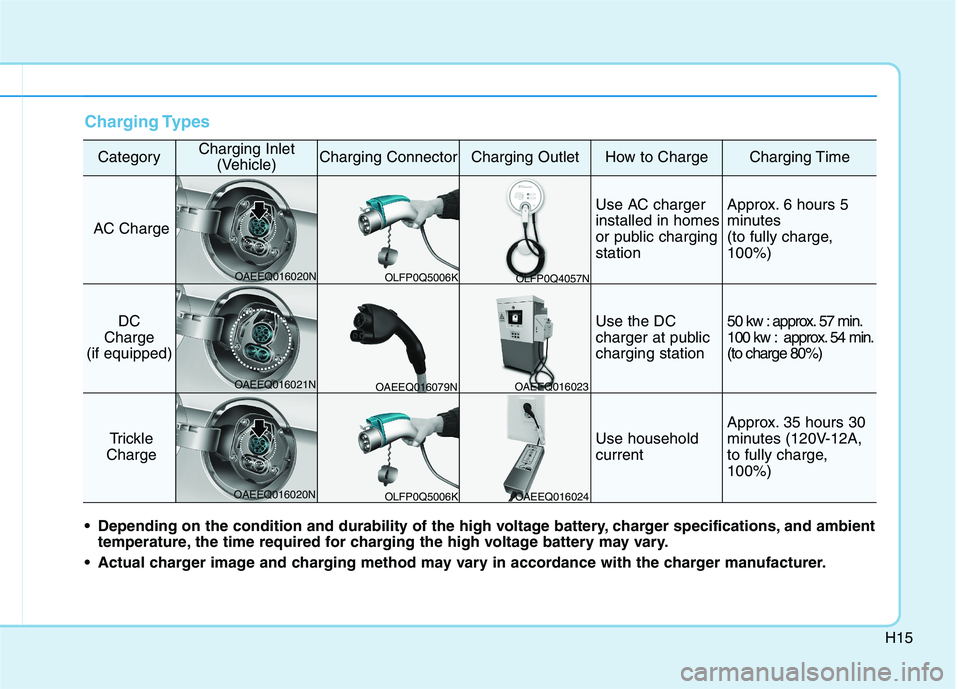
H15
Charging Types
CategoryCharging Inlet(Vehicle)Charging ConnectorCharging OutletHow to ChargeCharging Time
AC Charge
Use AC charger installed in homes
or public chargingstationApprox. 6 hours 5
minutes
(to fully charge,100%)
DC
Charge
(if equipped)Use the DC
charger at publiccharging station50 kw : approx. 57 min.
100 kw : approx. 54 min.(to charge 80%)
Trickle
Charge Use household current
Approx. 35 hours 30
minutes (120V-12A,
to fully charge,100%)
Depending on the condition and durability of the high voltage battery, charger specifications, and ambient temperature, the time required for charging the high voltage battery may vary.
Actual charger image and charging method may vary in accordance with the charger manufacturer. OLFP0Q5006K
OAEEQ016020N
OAEEQ016021N
OAEEQ016020N OAEEQ016079N
OAEEQ016023
OAEEQ016024 OLFP0Q4057N
OLFP0Q5006K
Page 25 of 546
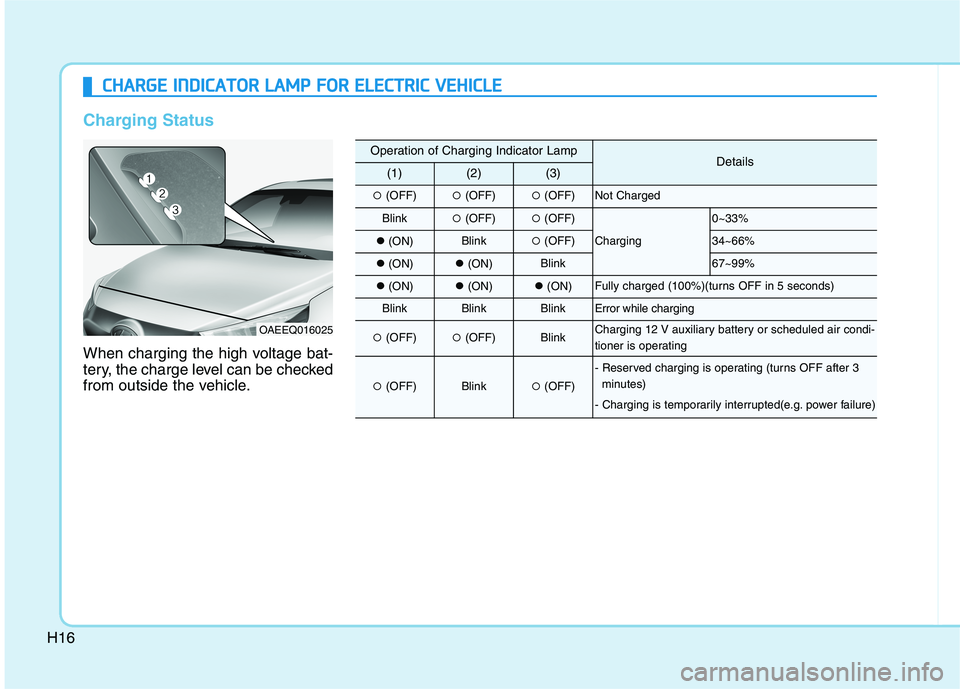
H16
CCHH AARRGG EE IINN DDIICC AA TTOO RR LL AA MM PP FF OO RR EE LLEE CCTT RR IICC VV EEHH IICC LLEE
Charging Status
When charging the high voltage bat-
tery, the charge level can be checked
from outside the vehicle.
OAEEQ016025
Operation of Charging Indicator LampDetails(1)(2)(3)
� (OFF)� (OFF)�(OFF)Not Charged
Blink� (OFF)�(OFF)
Charging
0~33%
�(ON)Blink� (OFF)34~66%
�(ON)�(ON)Blink67~99%
�(ON)�(ON)�(ON)Fully charged (100%)(turns OFF in 5 seconds)
BlinkBlinkBlinkError while charging
� (OFF)� (OFF)BlinkCharging 12 V auxiliary battery or scheduled air condi-
tioner is operating
�(OFF)Blink�(OFF)
- Reserved charging is operating (turns OFF after 3
minutes)
- Charging is temporarily interrupted(e.g. power failure)
Page 26 of 546

H17
Locking Charging Cable
You may select when the charging
connector can be locked and
unlocked in the charging inlet.
The driver can select the charge con-
nector lock mode from the User
Settings in the LCD display by
selecting ‘User Settings �
Convenience � Locking Charging
Cable’.
When the Charging Connector
is Locked
Always mode :
The connector locks when thecharging connector is plugged into
the charging inlet. The connector is
locked until all doors are unlocked
by the driver. This mode can be
used to prevent charging cabletheft.
- If the charging connector isunlocked when all doors are
unlocked, but the charging cableis not disconnected within 15 sec-
onds, the connector will be auto-
matically locked again.
- If the charging connector is unlocked when all doors are
unlocked, but all doors are locked
again, immediately, the connector
will be automatically lockedagain. While charging mode :
The connector locks when charg-
ing starts. The connector unlocks
when charging is complete. Thismode can be used when charging
in a public charging station.
Do not lock mode : The connector unlock regardlessof the state of charging. Press the charging connector
release button, disconnect the con-
nector.
Be careful to prevent of the charg-
ing cable.
CCHH AARRGG IINN GG CC OO NNNNEECCTT OO RR LL OO CCKK
OAEEQ019085R
While
chargingAlwaysDo not lock
Before chargingXOX
While chargingOOX
Finished chargingXOX
Page 27 of 546

H18
Scheduled Charging (if equipped)
You can set-up a charging sched-ule for your vehicle using the info- tainment system or Blue Link appli-cation.
Refer to the infotainment system
manual or the Blue Link manual for
detailed information about settingscheduled charging.
Scheduled charging can only be done when using a AC charger or
the portable charger (ICCB: In-
Cable Control Box). When scheduled charging is set
and the AC charger or the portable
charger (ICCB: In-Cable Control
Box) is connected for charging, the
indicator lamp in the middle blinks
(for 3 minutes) to indicate thatscheduled charging is set.
When scheduled charging is set, charging is not initiated immediate-
ly when the AC charger or portable
charger (ICCB: In-Cable Control
Box) is connected. When immedi-ate charging is required, use the
infotainment system to deactivatethe scheduled charge setting or
press schedule charging deactiva-
tion ( ) button. If you press the scheduled charg-
ing deactivation ( ) button to
immediately charge the battery,
charging must be initiated 3 min-
utes after the charging cable hasbeen connected.
When you press the scheduled
charging deactivation ( ) for imme-diate charging, the scheduledcharge setting is not completely
deactivated. If you need to com-
pletely deactivate the scheduled
charge setting, use the infotainment
system to finalize the deactivation.
Refer to "AC Charge or Trickle
Charge" for details about connecting
the normal charger and the portable
charger (ICCB: In-Cable Control Box).
OAEEQ016026
SS CC HH EEDD UU LLEE DD CC HH AARRGG IINN GG
OAEEQ019027
Page 28 of 546
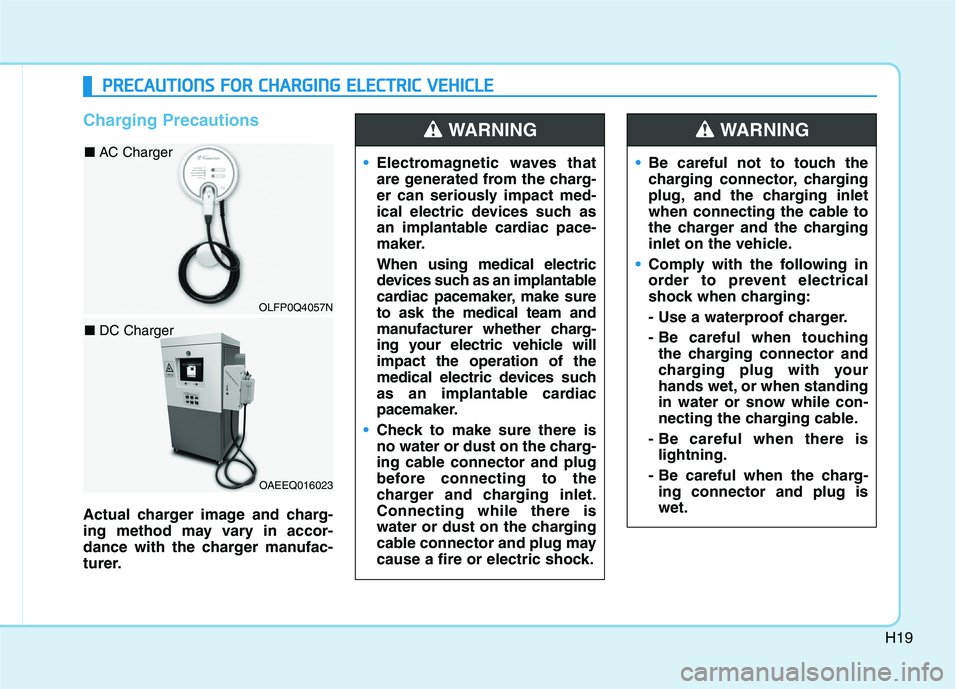
H19
Charging Precautions
Actual charger image and charg-
ing method may vary in accor-
dance with the charger manufac-
turer.
Electromagnetic waves that
are generated from the charg-
er can seriously impact med-
ical electric devices such as
an implantable cardiac pace-
maker. When using medical electric
devices such as an implantable
cardiac pacemaker, make sureto ask the medical team and
manufacturer whether charg-
ing your electric vehicle willimpact the operation of the
medical electric devices such
as an implantable cardiac
pacemaker.
Check to make sure there is
no water or dust on the charg-
ing cable connector and plug
before connecting to the
charger and charging inlet.Connecting while there is
water or dust on the charging
cable connector and plug may
cause a fire or electric shock.
WARNING
Be careful not to touch the
charging connector, charging
plug, and the charging inlet
when connecting the cable to
the charger and the charging
inlet on the vehicle.
Comply with the following in
order to prevent electrical
shock when charging:
- Use a waterproof charger.
- Be careful when touchingthe charging connector and
charging plug with your
hands wet, or when standing
in water or snow while con-
necting the charging cable.
- Be careful when there is lightning.
- Be careful when the charg- ing connector and plug iswet.
WARNING
PP RR EECCAA UU TTIIOO NNSS FF OO RR CC HH AARRGG IINN GG EE LLEE CCTT RR IICC VV EEHH IICC LLEE
OAEEQ016023
■
DC Charger
OLFP0Q4057N
■
AC Charger
Page 29 of 546

H20
Immediately stop charging
when you find abnormal
symptoms (odor, smoke).
Replace the charging cable if
the cable coating is damaged
to prevent electrical shock.
When connecting or removing
the charging cable, make sure
to hold the charging connec-
tor handle and charging plug.
If you pull the cable itself
(without using the handle), the
internal wires may disconnect
or get damaged. This may lead
to electric shock or fire.
WARNING
Always keep the charging con-
nector and charging plug in
clean and dry condition. Be
sure to keep the charging
cable in a condition where
there is no water or moisture.
Make sure to use the designat-
ed charger for charging the
electric vehicle. Using any
other charger may cause fail-
ure.
Before charging the battery,
turn the vehicle OFF.
When the vehicle is switched
OFF while charging, the cool-ing fan inside the motor com-
partment may automatically
operate. Do not touch the cool-
ing fan while charging.
Be careful not to drop the
charging connector. The
charging connector can be
damaged.
CAUTION
PPRR EECCAA UU TTIIOO NNSS FF OO RR CC HH AARRGG IINN GG EE LLEE CCTT RR IICC VV EEHH IICC LLEE (( CC OO NNTT..))
Page 30 of 546
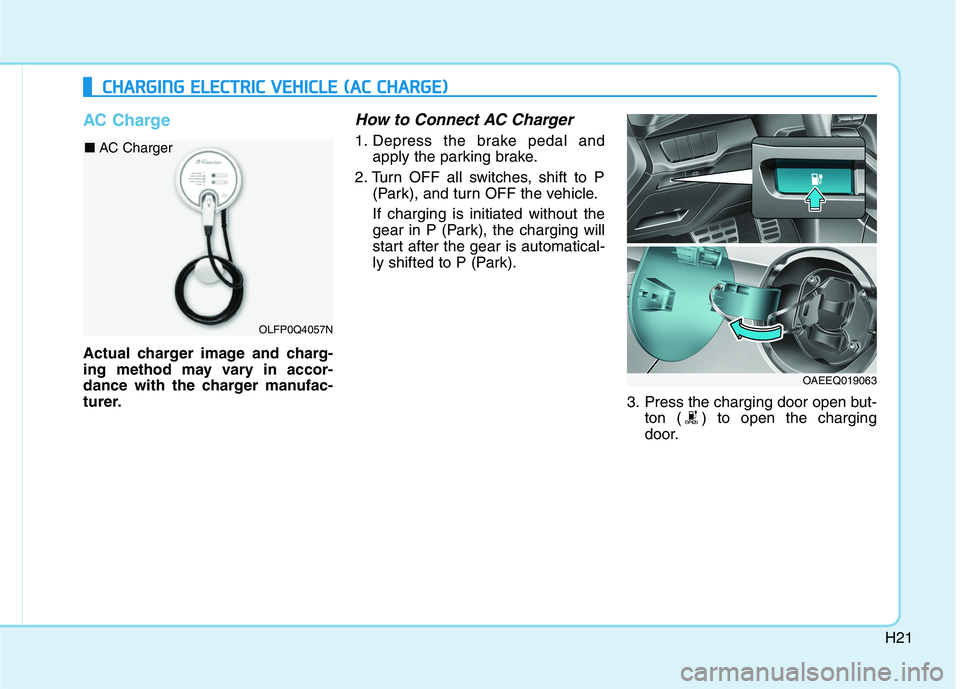
H21
AC Charge
Actual charger image and charg-
ing method may vary in accor-
dance with the charger manufac-
turer.
How to Connect AC Charger
1. Depress the brake pedal andapply the parking brake.
2. Turn OFF all switches, shift to P (Park), and turn OFF the vehicle. If charging is initiated without the
gear in P (Park), the charging will
start after the gear is automatical-
ly shifted to P (Park).
3. Press the charging door open but-ton ( ) to open the charging
door.
CCHH AARRGG IINN GG EE LLEE CCTT RR IICC VV EEHH IICC LLEE (( AA CC CC HH AARRGG EE))
OLFP0Q4057N
■
AC Charger
OAEEQ019063